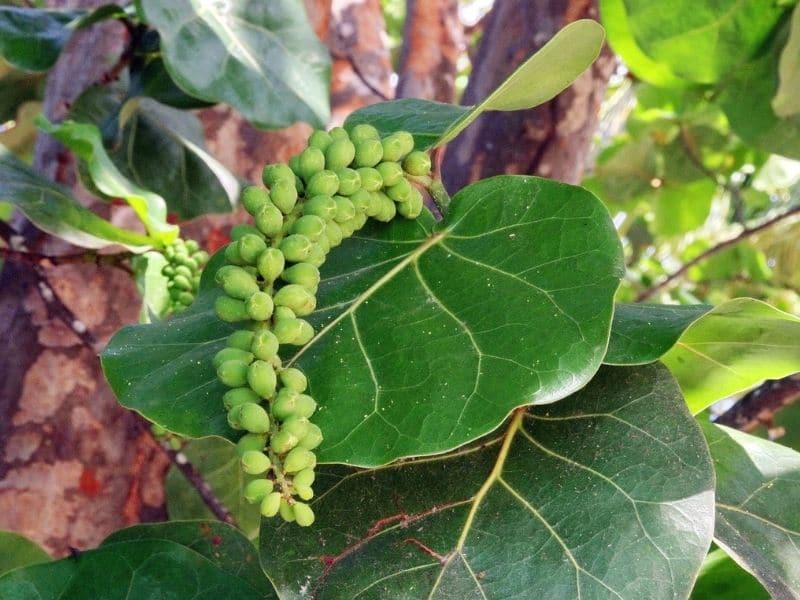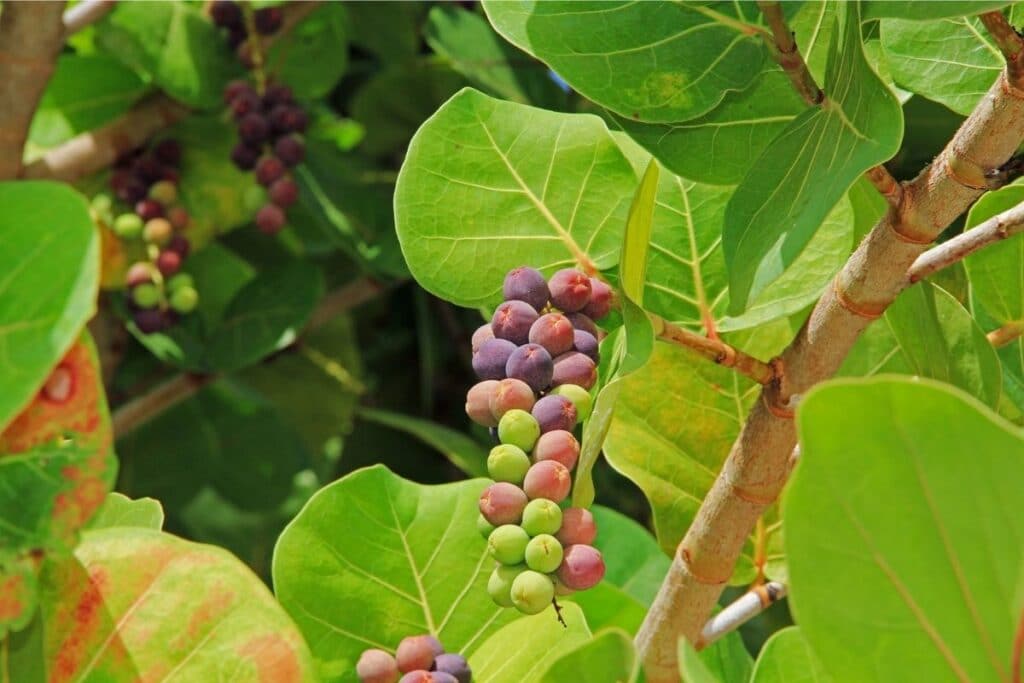The sea grape is a classic and characteristic plant of the sunny state of Florida. Its lovely large evergreen leaves provide valuable shade and its versatility makes it a good choice in a variety of settings.
Read on to learn more and find out whether this is the right plant for you.
What Is A Sea Grape?
The sea grape (Coccoloba uvifera) is an evergreen plant that may occur as a shrub or tree depending on the conditions in which it is grown. It is known by several common names, including horsewood, hopwood, jamaica kino and seaside grape.
This plant varies significantly in height and growth form and can max out at between three and 50 feet (1-15m) in height. Sea grapes are a tropical species, occurring naturally in the coastal areas of South America, the Caribbean and South Florida.
The attractive bark of this plant is smooth and light in color, displaying shades of gray-brown and white. The large, alternately arranged leaves are rounded in shape and around 8 to 10 inches (20 – 25 cm) in diameter.
These large leaves are characteristic of the plant and have prominent and attractive red veins. New growth has a bronzy-red color. Young leaves are reddish and older leaves will also turn red before dropping from the plant.
In nature, thesesea grape trees are found at low altitudes from beach dunes to about 1500ft (500m) above sea level and is well adapted to withstand the windy conditions and salt spray associated with coastal areas.

Sea Grape Flowers
The sea grape tree produces small but beautiful flowers which are cream to white in color. Flowers are borne in elongated clusters and may occur throughout the year, although there is a peak in spring and summer.
These trees produce fruit in mid-summer and are a little smaller than a grape in size. The fruits are attractive and are bright green, ripening to red to purple in color.
How To Grow Sea Grape Tree
Sea grapes are propagated organically by seed, but you have no control over the gender or other features of the tree. Taking cuttings from an existing plant may produce more reliable results than sown seedlings. You may also get a nursery tree, which will grow into a massive tree much faster.
The pulp is removed from fruits and the seed is planted in a sterile substrate such as perlite. Keep your seeds moist and at about room temperature and they should germinate in about 3 weeks.
3-4 inch (7.5-10cm) cuttings of this plant will also take well in moist soil and warm, humid environment.
This plant can be planted in partial shade, but it prefers full sun exposure. This plant is a tropical species and therefore does not tolerate temperatures below freezing. This plant does best when grown in USDA hardiness zones 10 to 11.
If subjected to freezing conditions, the leaves of this plant will turn red before falling. Older specimens may survive brief frosts but this plant is certainly not suitable for cold climates.
Sandy soil is best for these trees. This drought tolerant plant prefers well-drained soils with a neutral to slightly alkaline pH but can tolerate 5.8–8. Like most coastal plants, sea grapes are very tolerant of windy conditions.
It is important to bear in mind that this is a dioecious species, which means that individual plants are male or female but not both.
Fruits are only produced on female plants and require fertilization by nearby male plants. Therefore, if you plan on growing this plant for its fruits, it is recommended that you take cuttings from both a male and female plant and grow one of each in close proximity.
Alternatively, you can grow seagrape from seed and select a male and female once identifiable, although patience is required as these plants may take as long as 6 to 8 years to begin flowering.
Sea Grape Care and Maintenance
Regular watering in the morning is recommended so that there is moisture available to the roots throughout the day. Your sea grape plant will do best in a well-drained soil mix, but take care not to overwater in less well-draining substrates.
Remember to water the young plant frequently until it is established.
During establishment, keep the area below your plant weed-free to reduce competition for water and nutrients. A layer of mulch under your plant will also assist in moisture retention but leave the area immediately around the stem mulch free.
Pruning is a necessary maintenance procedure that aids in the preservation of desired shape, growth control, and general plant health. If left to its own devices, this plant tends to develop into a single-stemmed tree form when planted inland, away from the harsh conditions associated with dune environments.
Avoid pruning during the growing season since it might stress the plant.
Where a hedge or shrub form is desirable, pruning in late spring and early summer is best. Cut stems just above leaves at a 45-degree angle, this plant can withstand quite heavy pruning.
This is generally a hardy species, but some plants may host aphids and borers. One of the most popular ones is the seagrape borer, a natural moth that bores into twigs and short, small branches, destroying them as well as the leaves that are connected to them. Typically, the harm is modest. A nipple gall appears as red lumps on the upper surface surface of the leaves.
To get rid of nipple gall, consider bringing beneficial insects into your garden or applying neem oil or insecticidal soap on a weekly basis.
The large leaves of this plant lend it an interesting look. However, due to the size of those leaves, manual pruning is suggested as power hedge trimmers are likely to rip individual leaves, creating an untidy appearance.
This plant tends to shed a lot of leaves, fruits and flowers, and its pollen may cause allergies in some people, factors that should be considered when selecting a planting site.
Uses
Sea grapes make a fine ornamental shrub, with large interesting and attractive foliage. These sea grape trees also make a useful screen.
With regular pruning, this plant can be grown as a loose but attractive and interesting hedge or even arch. However, away from the coast, these plants tend to prefer growing in a tree form, and there, hedging will take a little more work.
These plants have plenty of uses. The fruits are edible and may be eaten raw or used to make jams and jellies Etc.
The wood of these plants can also be used In the construction of furniture as well as a fuel source and its sap can be used as a dye or for tanning.
The fruits are eaten by birds and the flowers provide a valuable source of nectar to honeybees.
FAQs
What is the lifespan of sea grapes?
The lifespan of sea grapes (Coccoloba uvifera) can vary, but they are generally long-lived trees with a potential lifespan of several decades. In optimal conditions, they can thrive and continue to grow for 50 years or more.
Are sea grapes Coccoloba uvifera rare?
Sea grapes, scientifically known as Coccoloba uvifera, are not considered rare. They are common in coastal areas of tropical and subtropical regions, particularly in the Caribbean and Florida. However, factors such as habitat loss and environmental changes can impact their local abundance.
Conclusion
The sea grape is an excellent plant for landscaping in tropical coastal areas where it’s perfectly adapted to the seaside environment. Unfortunately, this plant may not be the best option for planting as a shrub or hedge inland due to its natural tree-like growth form, manual pruning requirements and sensitivity to cold weather.
*image by Lindasj2/depositphotos







